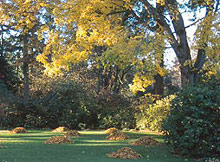Threat
The Dunn Gardens faces three primary threats to its integrity: subdivision, off-site forest removal, and the loss of trees (on- and off-site) due to age. Combined, these three factors could alter both the site's spatial character and its on-site microclimate.
Subdivision
Like many country place estates across the country, the Dunn Gardens has been altered -- and will continue to be threatened -- by land subdivision. The eastern quarter of the combined 20-acre parcel was subdivided in the 1950s: while not part of the Olmsted planting plan, it was intended to provide a native forest transition from the city to the countryside. The remaining Dunn property was subdivided among the Dunn siblings. The Agen half of the remaining site was further subdivided into several residential parcels in the 1960s. The Agen house and service structures are now separated by newer residences, fragmenting what remained of the Olmsted plan. As this nomination is being written, the Trust board is working with the owners of one of these parcels to prevent its further subdivision.
Two years ago, upon the death of Dorothy Bayley, the last of Arthur Dunn's children, her house was sold outside of the family. The Trust had long-range aspirations for a visitor/education facility, a suitable use for this structure. Unfortunately, neither family nor Trust funds were available to buy it. Fortunately, again, sellers and buyers agreed to a strict development envelop that limits the visual impact of potential house alterations on the historic integrity of the overall site. Working with buyers who enthusiastically support the garden's mission, the Trust continues to direct rehabilitation and maintenance of that portion of the site suitably for public tours. As the Trust endowment is modest, the foreseeable need for future property sales poses a definite threat to the garden.
Declining neighborhood forest
The tendency of owners of smaller neighboring lots to remove mature trees - either through fear of damage from falling trees or to clear sites for the construction of larger houses - threatens the neighborhood forest. Eventually the extant trees within the Dunn Gardens will be an island forest, ever more vulnerable to exposure and wind damage.
Nature itself
The third threat is the result of the natural growth patterns of the Dunn Gardens forest itself. The native Douglas Firs are reaching mature heights above 150 feet. The Eastern hardwoods are nearing a century in age; in the milder Northwest climate, they also have reached extraordinary size and are prey the weaknesses associated with such growth. Many of these trees will die within the next few decades.


